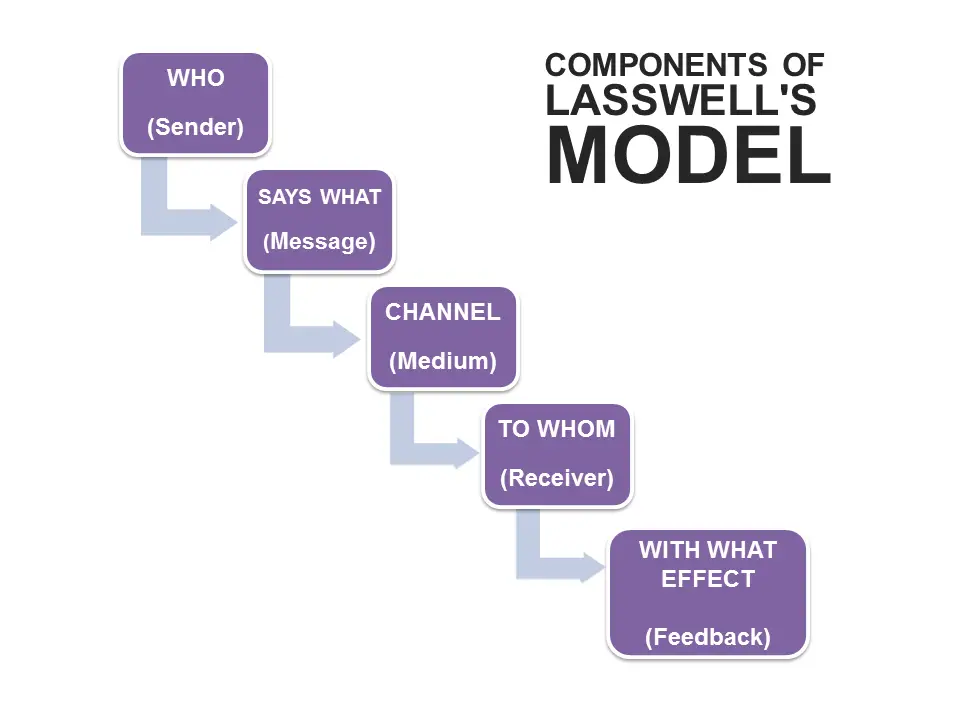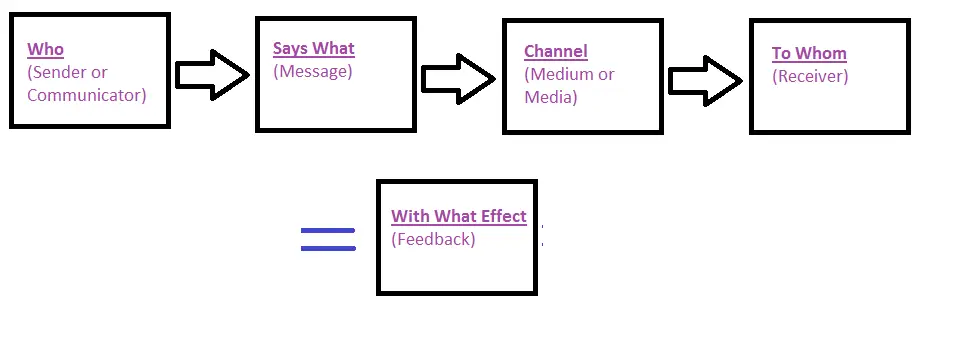Lasswell’s communication model was developed by communication theorist Harold D. Lasswell (1902-1978) in 1948. Lasswell’s model of communication (also known as action model or linear model or one way model of communication) is regarded as one the most influential communication models.
Components of Lasswell’s Communication Model

Lasswell’s communication model has 5 components which is used as an analysis tool for evaluating the communication process and components. The components are the questions to be asked to get the answers and keep communication going.
| Components | Meaning | Analysis |
|---|---|---|
| Who | the communicator or sender or source of message | Control Analysis |
| Says What | the content of the message | Content Analysis |
| In Which Channel | the medium or media | Media Analysis |
| To Whom | the receiver of the message or an audience | Audience Analysis |
| With What Effect | the feedback of the receiver to the sender | Effect Analysis |
Explanation of different Components of Lasswell’s Model
- Control analysis helps the sender to have all the power.
- Content analysis is associated to stereotyping and representation of different groups politically. It is also related to the purpose or the ulterior motives of the message.
- Media analysis represents which medium should be used to exercise maximum power against the receivers.
- Audience analysis shows who are the target population to be manipulated or brain-washed.
- Effect analysis is done before the process starts. It is used to predict the effect of message over the target population to be exploited.
Explanation of Lasswell’s Communication Model
Though Lasswell’s model was developed to analyze mass communication, this model is used for interpersonal communication or group communication to be disseminated message to various groups in various situations.
Lasswell’s model was developed to study the media propaganda of countries and businesses at that time. Only rich people used to have communication mediums such as televisions and radios back them. It was made to show the mass media culture.

Lasswell also brought the concept of Effective Communication Process. He talked about the relation between presentation of facts and how it generates different effects. The use of the concept of effect makes Lasswell’s model non-linear unlike it’s name. It’s because effect can also be taken as feedback.
Though, generally, the component of effect was made to be more about outcome of the message, the model is applied in different medias and fields despite being developed specifically for mass communication.
This model is similar to the communication model proposed by Claude Shannon and Warren Weaver. Their model is more graphical than Lasswell’s. George Gerbner who is the founder of the cultivation theory, expanded Lasswell’s model and included the concept of reaction of the receiver.
Disadvantages and Criticisms of Lasswell’s Model
The major criticism of Lasswell’s Model is that it does not include feedback and it ignores the possibility of noise. Without feedback, a communication process can not be fruitful. Lasswell’s model is very linear and does not consider barriers in the communication process.
The model is also criticized for being very general and only including very traditional topics. The model is very simplistic. The model is said to be propaganda based as it is more focused on the resulting outcome and generally used for media persuasion.
